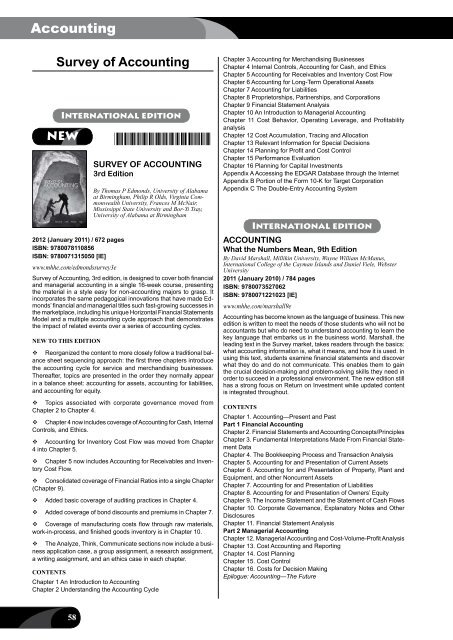Download - McGraw-Hill Books
Download - McGraw-Hill Books
Download - McGraw-Hill Books
- No tags were found...
You also want an ePaper? Increase the reach of your titles
YUMPU automatically turns print PDFs into web optimized ePapers that Google loves.
AccountingSurvey of AccountingInternational editionNEW*9780078110856*2012 (January 2011) / 672 pagesISBN: 9780078110856ISBN: 9780071315050 [IE]www.mhhe.com/edmondssurvey3eSURVEY OF ACCOUNTING3rd EditionBy Thomas P Edmonds, University of Alabamaat Birmingham, Philip R Olds, Virginia CommonwealthUniversity, Frances M McNair,Mississippi State University and Bor-Yi Tsay,University of Alabama at BirminghamSurvey of Accounting, 3rd edition, is designed to cover both financialand managerial accounting in a single 16-week course, presentingthe material in a style easy for non-accounting majors to grasp. Itincorporates the same pedagogical innovations that have made Edmonds’financial and managerial titles such fast-growing successes inthe marketplace, including his unique Horizontal Financial StatementsModel and a multiple accounting cycle approach that demonstratesthe impact of related events over a series of accounting cycles.New to this editionReorganized the content to more closely follow a traditional balancesheet sequencing approach: the first three chapters introducethe accounting cycle for service and merchandising businesses.Thereafter, topics are presented in the order they normally appearin a balance sheet: accounting for assets, accounting for liabilities,and accounting for equity.Topics associated with corporate governance moved fromChapter 2 to Chapter 4.Chapter 4 now includes coverage of Accounting for Cash, InternalControls, and Ethics.Accounting for Inventory Cost Flow was moved from Chapter4 into Chapter 5.Chapter 5 now includes Accounting for Receivables and InventoryCost Flow.Consolidated coverage of Financial Ratios into a single Chapter(Chapter 9).Added basic coverage of auditing practices in Chapter 4.Added coverage of bond discounts and premiums in Chapter 7.Coverage of manufacturing costs flow through raw materials,work-in-process, and finished goods inventory is in Chapter 10.The Analyze, Think, Communicate sections now include a businessapplication case, a group assignment, a research assignment,a writing assignment, and an ethics case in each chapter.ContentsChapter 1 An Introduction to AccountingChapter 2 Understanding the Accounting CycleChapter 3 Accounting for Merchandising BusinessesChapter 4 Internal Controls, Accounting for Cash, and EthicsChapter 5 Accounting for Receivables and Inventory Cost FlowChapter 6 Accounting for Long-Term Operational AssetsChapter 7 Accounting for LiabilitiesChapter 8 Proprietorships, Partnerships, and CorporationsChapter 9 Financial Statement AnalysisChapter 10 An Introduction to Managerial AccountingChapter 11 Cost Behavior, Operating Leverage, and ProfitabilityanalysisChapter 12 Cost Accumulation, Tracing and AllocationChapter 13 Relevant Information for Special DecisionsChapter 14 Planning for Profit and Cost ControlChapter 15 Performance EvaluationChapter 16 Planning for Capital InvestmentsAppendix A Accessing the EDGAR Database through the InternetAppendix B Portion of the Form 10-K for Target CorporationAppendix C The Double-Entry Accounting SystemInternational editionACCOUNTINGWhat the Numbers Mean, 9th EditionBy David Marshall, Millikin University, Wayne William McManus,International College of the Cayman Islands and Daniel Viele, WebsterUniversity2011 (January 2010) / 784 pagesISBN: 9780073527062ISBN: 9780071221023 [IE]www.mhhe.com/marshall9eAccounting has become known as the language of business. This newedition is written to meet the needs of those students who will not beaccountants but who do need to understand accounting to learn thekey language that embarks us in the business world. Marshall, theleading text in the Survey market, takes readers through the basics:what accounting information is, what it means, and how it is used. Inusing this text, students examine financial statements and discoverwhat they do and do not communicate. This enables them to gainthe crucial decision-making and problem-solving skills they need inorder to succeed in a professional environment. The new edition stillhas a strong focus on Return on Investment while updated contentis integrated throughout.ContentsChapter 1. Accounting—Present and PastPart 1 Financial AccountingChapter 2. Financial Statements and Accounting Concepts/PrinciplesChapter 3. Fundamental Interpretations Made From Financial StatementDataChapter 4. The Bookkeeping Process and Transaction AnalysisChapter 5. Accounting for and Presentation of Current AssetsChapter 6. Accounting for and Presentation of Property, Plant andEquipment, and other Noncurrent AssetsChapter 7. Accounting for and Presentation of LiabilitiesChapter 8. Accounting for and Presentation of Owners’ EquityChapter 9. The Income Statement and the Statement of Cash FlowsChapter 10. Corporate Governance, Explanatory Notes and OtherDisclosuresChapter 11. Financial Statement AnalysisPart 2 Managerial AccountingChapter 12. Managerial Accounting and Cost-Volume-Profit AnalysisChapter 13. Cost Accounting and ReportingChapter 14. Cost PlanningChapter 15. Cost ControlChapter 16. Costs for Decision MakingEpilogue: Accounting—The Future58
















